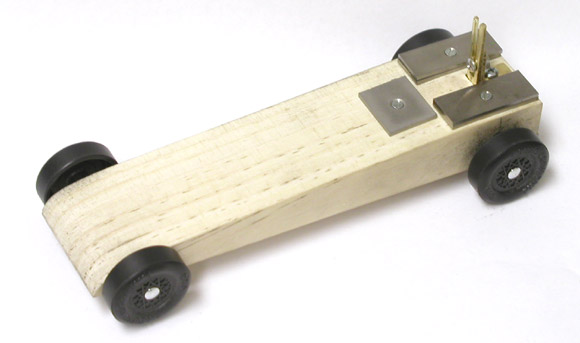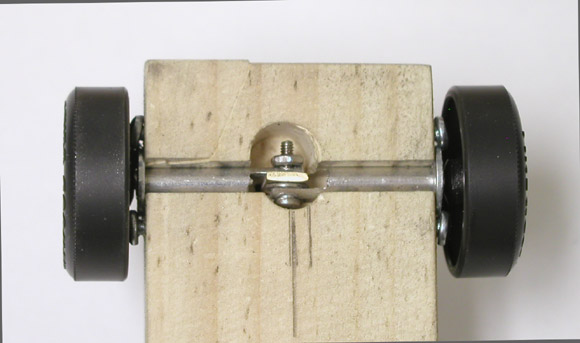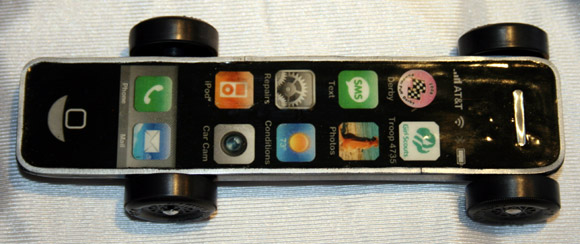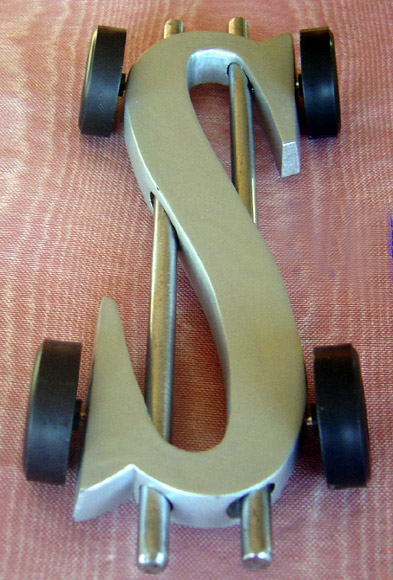– Feature Article – Canted Axles Revisited
– Pinewood Derby Car Showcase
– Memory – Magic Car
– Q&A
Canted Axles Revisited
The term “canted” means setting an object at an angle. Thus, “canted axles” are axles which are attached to the car at an angle. Sometimes this is done accidentally, but usually car builders cant axles in an attempt to reduce the amount of contact between the wheel tread and the track.
When discussing canted axles, the following questions must be asked:
- Is there an advantage to canted axles? We will attempt to determine this with an experiment.
- Which type of canting (up or down) would provide the most benefit? (see Figure 1) Generally, up canting is chosen as the wheel to car body contact is eliminated, and the car body is lowered. However, the guide rail contact is increased with up canting.
- What is the optimum canting angle? We will attempt to determine this with an experiment.

Previous Experiment
Back in December of 2003 I conducted an experiment measuring the effect of canted axles (see Pinewood Derby Times, Volume 3, Issue 6, “The Big Debates Part 4: Canted Axles”, December 10, 2003). The results of that experiment were that, in general, up-canted axles were not beneficial. These results were supported by an experiment from another person, as well as from mathematical models.
Changes Needed
Since then, I have had many discussions with various people regarding the results of this experiment versus the anecdotal support for canting. So I decided to rerun the experiment with some key changes. The main changes to the experimental method were:
Original experiment
- Four wheels on ground,
- Front and back canted equally,
- Cant angle adjusted by using multiple axle holes (axles had to be pulled and then reinserted to try a different angle. Unfortunately, this introduced experimental error.
New experiment
- Three wheels on the ground,
- Front dominant wheel not canted, but shimmed to cause rail-riding,
- Cant angle of rear axles synchronously adjusted with a mechanism (eliminates error introduced by pulling axles, and using multiple axle holes).
New Experiment
Equipment
The main equipment for this experiment is a car with an adjustable rear cant. Figures 2 through 4 show this car.

Note the fork of brass protruding out of the car. The fork is held in place by a screw into an L-bracket mounted on the car. When the screw is loosened, the fork can be moved up or down, adjusting the cant angle.

The fork from Figure 1 is connected to two aluminum tubes, which are press fitted into a slot milled into the bottom of the car. As the fork is moved up and down, the aluminum tubes synchronously move up and down. The axles are pressed into the aluminum tubes. (Note that the chip on the upper left is cosmetic; it doesn’t affect the mechanism).

To force the aluminum tubing to move up and down at an angle, the end of each tube is supported by a washer. The screws hold the washer in place (I wasn’t sure if epoxy alone would hold the washer). The washer has a close fit with the tubing, so it does limit the amount of cant that can be applied to approximately 6 degrees down or up.
To set the desired cant angle, a little trigonometry is used. First, the length of one aluminum rod is measured (L). Then the up-down offset of the center part of the rod is measured (O). With this information, the following formula provides the cant angle:
Angle = arcsin(O/L)
This can also be worked in reverse to calculate the desired offset:
O = sin(desired angle) x L
Additional equipment for the experiment includes:
- 32 Foot Aluminum Freedom Track, the track was leveled with a bubble level and shims.
- Rear weighted extended wheelbase wedge weighing five ounces, front- left wheel raised
- Max-V-Lube Graphite
- Ultralight Speed Wheels from DerbyWorx
- Speed Axles from Maximum Velocity
Procedure
The car was first aligned to rail-ride (see Volume 8, Issue 4), and then a few break-in heats were run. Then the following sequence was followed.
- 5 runs, 0 degrees cant
- 5 runs, 3 degrees up cant
- 10 runs, 5 degrees up cant
- 5 runs, 3 degrees up cant
- 5 runs, 0 degrees cant
After the heats were run, the high and low times were removed and the remaining heats averaged.
Results
The results of the experiment are shown in Figure 5.

Note the time scale on the left is in milliseconds. The results indicate that there is a very small improvement in performance by up-canting the rear axles. However, note that this is not an absolute conclusion as the statistical variation of the heat times is greater than the 3 milliseconds absolute difference in times. So, there may actually be no real improvement.
Conclusions
We can certainly say that accurately up-canting the rear wheels on a smooth aluminum track is not a disadvantage, and may provide a slight advantage. However, the benefit of canting on a rough track is unknown, but may provide a more noticeable advantage.
Pinewood Derby Car Showcase
iPhone: Hope Wallace


Silver Dollar: Bryan Solby
This car was a prototype and never actually raced. It was an idea we came up with and wanted to see if it was doable. The “S” body is made of 3/4 inch pine, cut on a band saw. The rods are 1/4 inch steel, approximately 7 inches long. The car, wheels, axles, and rods weigh just under 5 ounces. Originally it was painted green — because dollars are green — but later was repainted sliver and named the “Silver Dollar.”
Pinewood Derby Memory
Magic Car?
Our local church race was interesting this year — for me anyway. I usually try to build a nice car, but since I started hosting the event I haven’t been very careful to make it fast so that someone else can win. This year I was so rushed I didn’t even sand my car — only rough cut. About a half hour before I had to go to the race, I cut the tab off the Awana wheels, sanded around the edges to make sure they were smooth, and placed several drops of NyOil II on each axle (contrary to instructions). I then installed the axles in the original holes, made sure they had some side clearance (but I didn’t measure it), and added weights (not too accurately). The car weighed in light at 4.7 ounces.
So, what a surprise it was to see my car running first! Not only was it faster than the stock cars I raced, but it was faster than the times posted by the modified cars. I saw the car fishtail on a couple of races, so I can only imagine what the car could have done with tighter tolerances and more weight. Luck? Hmmm.
Corey
NC Awana State Grand Prix Open Coordinator
Q&A
Riding the Rail would not seem to be a winning strategy if the goal is to reduce friction? How does this work?
If you could get a car to roll down the track without contacting the guide rail, that of course would be best. But in reality, the car will contact the guide rail multiple times. The intent of the Rail Riding is to control which wheel contacts the rail, and how much contact is present.
A few key points:
- If you use a raised wheel, to get the benefit that wheel must not contact the rail.
- If your weight is in the back of the car, contact with a front wheel has less affect on performance than contact with a back wheel (more weight on the back means that rear wheel contact has more impact force than a contact with a front wheel).
So, the idea is to make the car contact only the front dominant wheel.
Did I read someplace that tungsten putty has about the same density as melted lead?
Tungsten putty (7.9 g/cm3) is denser than lead putty, but less dense than melted or solid lead (11.3 g/cm3). Please note that melting lead is a very risky. I strongly recommend using solid lead, or another metal such as tungsten.
Want Answers?
Do you have a pinewood derby-related question? If so, e-mail us your question.We answer all questions by e-mail, but not every question will appear in the Q&A section of the newsletter.
Back Issues
Are you a new subscriber, or have you missed some of the previous newsletters? Don’t miss out; all of the issues for Volume 5 through Volume 17 are posted on our web site.
Newsletter Contributions
We welcome your contributions. If you would like to contribute an article, a web site review, a speed tip, or a pinewood derby memory, please e-mail us.
Subscription Information
The Pinewood Derby Times is a free e-newsletter focused on pinewood derby racing. It is published biweekly from October through March.
If you haven’t already done so, please forward this issue to your pinewood derby friends. But please don’t subscribe your friends. Let them decide for themselves. Thanks.
If this newsletter was forwarded to you, why not subscribe to receive this newsletter. There is no cost, and your e-mail address is safe, as we never sell or share our distribution list.
To subscribe, send a blank e-mail to
pi*********************@*******st.com
You will receive a confirmation e-mail. Reply to the confirmation e-mail and you will start receiving the Pinewood Derby Times with the next issue.
Randy Davis, Editor, Pinewood Derby Times
E-Mail: in**@**************ty.com
(C)2018, Maximum Velocity, Inc. All rights reserved. Please do not reprint or place this newsletter on your web site without explicit permission. However, if you like this newsletter we grant permission, and encourage you to e-mail it to a friend.
Maximum Velocity disclaims any personal loss or liability caused by utilization of any information presented in this newsletter.
The Pinewood Derby Times is not specific to, and is not affiliated with the Boy Scouts of America, YMCA, Awana, or any other organization.
(R)Maximum Velocity is a registered trademark of Maximum Velocity, Inc.
(R)Pinewood Derby is a registered trademarks of the Boys Scouts of America.
(R)Awana is a registered trademark of Awana Clubs International.
All other names are trademarks of their respective owners.

